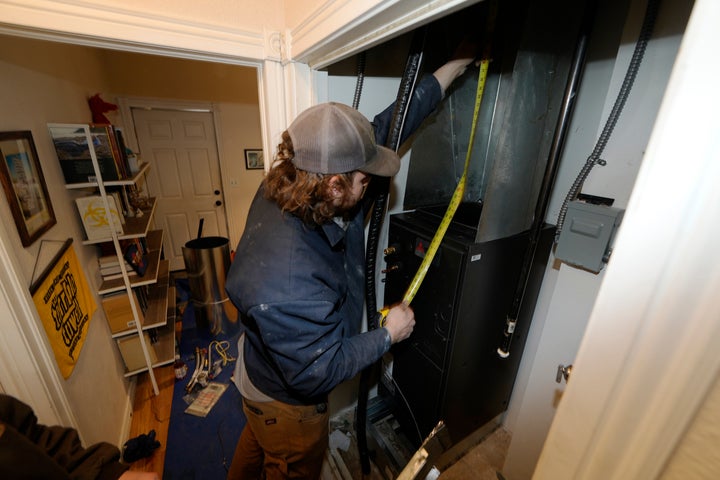Biden To Give Out Billions To Homeowners For Energy-Saving Renovations
Biden To Give Out Billions To Homeowners For Energy-Saving Renovations HuffPost


The Biden Administration Offers Tax Rebates for Sustainable Home Improvement Projects

The Biden administration started taking applications Thursday for billions of dollars in federal tax rebates meant to flow through states to subsidize home improvement projects that save energy or swap fossil-fueled appliances to electric alternatives.
The combined spending in the two separate programs of President Joe Biden’s landmark Inflation Reduction Act — one focused on energy-saving improvements like adding insulation or new windows, the other aimed at funding electrification like switching from gas-fired furnaces to heat pumps – totals more than $8.5 billion.
“Energy savings and electrification upgrades like insulating your home, installing a heat pump, or upgrading to electric Energy Star appliances, lower monthly utility costs and lead to healthier homes,” Secretary of Energy Jennifer Granholm said in a statement. “Americans living in energy efficient, electrified homes bring us one step closer to a clean, safer future.”
Once called the “fifth fuel” because the total amount of energy wasted roughly equals a whole new source of energy, efficiency efforts are a vital part of reversing the damage emissions from Americans’ cars, homes and businesses cause to the planet’s climate systems. The new federal spending marks what is likely the biggest national investment in history — and how the money flows from federal coffers to homeowners this time will likely set the standard for how future funding is doled out.

But success will ride on how state, territorial and tribal governments opt to design the programs for distributing the federal money.
In a 100-page regulatory document published Thursday afternoon, the Department of Energy detailed how it wants states to spend the money, establishing for the first time nationwide standards for measuring how much renovations shave off household utility bills and laying the groundwork for the U.S. to adopt a more modern, accurate method for cutting back on wasted energy.
Ahead of the announcement, advocates feared federal regulators may try to hasten how quickly the money was spent by giving states broad leeway to give out rebates for energy savings based on estimates rather than on measured reductions in energy usage, as HuffPost previously reported.
There are two main types of programs for energy savings. One, called the modeled approach, is less precise but more widely used by various states, relying on contractors’ projections of how much energy renovations should save. The other, called a measured approach, is used only in California, but compares data on energy usage before and after renovations and pays out rebates based on actual savings.
Measured programs, by some estimates, end up saving more than twice as much energy as modeled ones.
States will need to indicate in applications to the Energy Department for funding whether the money would go through modeled, measured or both types of programs.
States’ decisions on whether to choose measured programs, which fewer have experience with and which require access to utility data, will depend in large part on the federal regulations, which dictate the way the federal funds are spent.
Unlike the last time the federal government made a large pot of money available for energy efficiency upgrades, this time regulators set a national standard for measuring the energy usage, avoiding a problem that arose a decade ago under the Obama administration when companies struggled to track benefits state by state because the data didn’t line up.
“Both the modeled and the measured program options include energy data as an input into estimated or actual energy savings, with a few commonsense exceptions,” said Andy Frank, president of the climate-tech firm Sealed, which helps finance homeowners’ renovations upfront and gets paid back when the upgrades start cutting energy bills.
With this “data-driven approach,” he said, states will be able to “roll out both the modeled and the measured program options, a no regrets strategy that provides states with a safe foundation as well as a path to the future.”
Still, some Republican lawmakers have already vowed to fight to keep states from taking the federal rebate money, mirroring past refusals to accept Medicaid expansion funding from the Affordable Care Act or blocking city-level efforts to electrify buildings.
“None of our programs are easy to design working with states and territories. This is one where we’ve had extensive, extensive back and forth and we’ll continue to do so,” David Turk, a deputy energy secretary, said on a Thursday morning call with reporters. “The data issues are challenging, no doubt.”
But Michael Forrester, a senior official at the Energy Department who works on rebates, said the agency would be “building a robust set of data tools in order to track what is installed and as rebates are claimed, so we can monitor and measure the impacts over time.”
It’s not just about whether the energy savings are estimated through models or measured through data from smart meters or utility bills. Biden’s historic climate-spending law includes bigger benefits for low-income households
SDGs, Targets, and Indicators Analysis
1. Which SDGs are addressed or connected to the issues highlighted in the article?
- SDG 7: Affordable and Clean Energy
- SDG 11: Sustainable Cities and Communities
- SDG 13: Climate Action
The article discusses federal tax rebates for home improvement projects that save energy or switch appliances to electric alternatives. This aligns with SDG 7, which aims to ensure access to affordable, reliable, sustainable, and modern energy for all. It also relates to SDG 11, which focuses on making cities and human settlements inclusive, safe, resilient, and sustainable. Additionally, the article mentions the importance of energy efficiency in reducing emissions and addressing climate change, which is connected to SDG 13.
2. What specific targets under those SDGs can be identified based on the article’s content?
- SDG 7.3: By 2030, double the global rate of improvement in energy efficiency
- SDG 11.6: By 2030, reduce the adverse per capita environmental impact of cities, including by paying special attention to air quality and municipal and other waste management
- SDG 13.2: Integrate climate change measures into national policies, strategies, and planning
The article highlights the importance of energy-saving improvements and electrification upgrades in homes. These actions contribute to improving energy efficiency (SDG 7.3) and reducing the adverse environmental impact of cities (SDG 11.6). Additionally, the focus on reducing emissions from homes and businesses aligns with the need to integrate climate change measures into national policies (SDG 13.2).
3. Are there any indicators mentioned or implied in the article that can be used to measure progress towards the identified targets?
Yes, the article mentions indicators that can be used to measure progress towards the identified targets:
- Energy savings: The article discusses energy-saving improvements like adding insulation or new windows, which can be measured in terms of reduced energy consumption.
- Electrification upgrades: The article mentions switching from gas-fired furnaces to heat pumps as an example of electrification, which can be measured by the number of households or buildings that make this transition.
- Reduction in energy usage: The article compares the modeled approach (based on contractors’ projections) and the measured approach (based on actual energy usage data) for estimating energy savings. The use of the measured approach can serve as an indicator of progress in accurately measuring and reducing energy usage.
Table: SDGs, Targets, and Indicators
| SDGs | Targets | Indicators |
|---|---|---|
| SDG 7: Affordable and Clean Energy | 7.3: By 2030, double the global rate of improvement in energy efficiency | – Energy savings – Reduction in energy usage |
| SDG 11: Sustainable Cities and Communities | 11.6: By 2030, reduce the adverse per capita environmental impact of cities, including by paying special attention to air quality and municipal and other waste management | – Energy savings – Electrification upgrades |
| SDG 13: Climate Action | 13.2: Integrate climate change measures into national policies, strategies, and planning | – Energy savings – Electrification upgrades – Reduction in energy usage |
Behold! This splendid article springs forth from the wellspring of knowledge, shaped by a wondrous proprietary AI technology that delved into a vast ocean of data, illuminating the path towards the Sustainable Development Goals. Remember that all rights are reserved by SDG Investors LLC, empowering us to champion progress together.
Source: huffpost.com

Join us, as fellow seekers of change, on a transformative journey at https://sdgtalks.ai/welcome, where you can become a member and actively contribute to shaping a brighter future.







